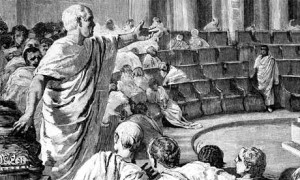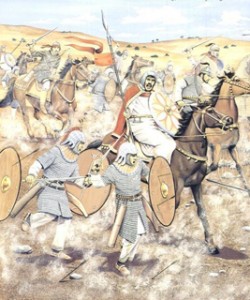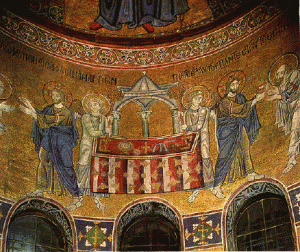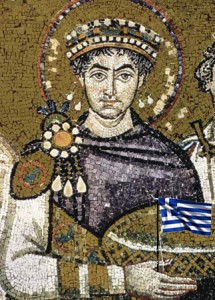 Chris asks if the Roman Senate moved with the capital to Constantinople.
Chris asks if the Roman Senate moved with the capital to Constantinople.
Constantine wanted his city to copy Rome in nearly every respect. Rome had 7 hills so Constantinople would too- even if it took some creative counting to reach seven on the Bosporus. He naturally intended for a Senate as well- not to replace the Roman one but to mirror it. But despite Constantine’s best effort, Constantinople’s version of the Senate was much less respected and originally functioned as a kind of city magistrate. As the importance of the city grew so did its Senate’s prestige.
Although power shifted decisively east in the 4th and 5th centuries, the two bodies- Roman and Constantinopolitan- existed side by side for a surprisingly long time. In the West the Senate outlasted the empire by several centuries. They continued to meet and pass legislation (mostly pertaining to city affairs) after the last emperor was put out to pasture in 476. Theodoric consulted them when he took possession of the city and Justinian officially restored some of their ancient privileges in the sixth century. There are records of them acclaiming eastern emperors until the seventh century and although they probably stopped meeting as a group sometime after that, senatorial families were still powerful in Medieval Italy. (The Orsini family for example claimed to be descended from the Julio-Claudians- a member of their clan was raised to the papal throne as late as the 18th century)
In the East, the Senate remained as a functioning body until the 13th century. Their last recorded act was raising the unfortunate Nicholaus Kanabus as emperor during the 4th Crusade. Their power had been declining for centuries (as detailed here) and their titles were empty, but there were Senators defending Constantinople’s walls on the morning of May 29, 1453.
 Manny asks how the initial Islamic conquerors of the 7th century were able to rule as a numerical minority.
Manny asks how the initial Islamic conquerors of the 7th century were able to rule as a numerical minority.
The Byzantine empire in 636- when the first Muslim army arrived- was a remarkably fragile thing. It was militarily exhausted from the bruising war with Persia, and more importantly it had deep internal divisions. Thanks to the interference of Theodora a generation before, the Monophysite heresy had flourished- especially in the provinces of Syria and Egypt which were now filled with religious separatists who viewed the central government of Constantinople as a foreign oppressor. They resented the distant capital for its heavy taxes (trying to recoup the outlays of the previous war) and interfering religious policies. When the Muslims arrived they were seen as preferable for a number of reasons. They were at least fellow Semites, and their religion (initially believed to be a new kind of Christian heresy) was not seen as a threat. Alexandria- one of the 5 great Patriarchates of the Church- voluntarily surrendered, and Jerusalem offered only 3 days of token resistance.
For their part, the Muslims were more than happy to initially rule with a light touch. The subjugated Christians were viewed as a tax base to fund further conquests and there were therefore few pushes for conversion. To most citizens the Islamic victory probably would have changed remarkably little at first. A local Arab governor took the place of the distant emperor but the machinery of government was left in place and literate ‘Greeks’ (the only ones who had the requisite experience) ran the bureaucracy. In some cases the business of administration was carried out in Greek for more than a century after the Arab takeover. The end result for those first centuries was more effective direct rule and lower taxes- and a general unwillingness to return to the empire.
Only after the conquests started to slow did things start to change for the worse for the original Byzantines. Muslim education had caught up to the point where non-Muslims were no longer needed to run the state, and local governments began to focus on conversion. Non-Muslims were second class citizens at best- there were increasingly heavier taxes to pay for the luxury of getting harassed and excluded from many public sector jobs. (A particularly terrible harassment during Ottoman times involved Christian families surrendering one son to be forcibly converted to Islam and enlisted in a special branch of the army) As the burdens got more onerous many took the easy way out and converted. By the time Byzantium recovered in the 10th century and went on the offensive again Islam was too entrenched to expel.

St. Sophia of Kiev
Jack asks how close early Russian culture was to Byzantine culture.
The Rus had contact with Constantinople at least as early as the 830’s, but the close ties began with the Rus adoption of Christianity in 989. As always with Byzantine policy, Christianity was the main vehicle for the transmission of culture. The first cathedrals in Russia were built by imported Byzantine architects and they were decorated by imperial artisans. St. Sophia of Kiev, the premier Rus architectural achievement of the 11th century, was modeled on the Hagia Sophia and its metropolitan was subordinated to the Patriarch of Constantinople. By the 1040’s a Byzantine traveler to Kiev would have found it at least visually familiar.
But Russian culture was never a simple copy of Byzantium. It took centuries for Christianity to spread across the vast Rus lands and only a select part of Byzantium was absorbed. For instance, although the Bible was rendered into Old Church Slavonic there is no evidence that any of the Greek treatises on philosophy, mathematics, or science were translated. In other words, the Rus were only interested in some aspects of imperial culture- mostly the magnificent pageantry. The divine liturgy was imported along with the dress and trappings of the court, but the literature was passed up. By the end of the 11th century Constantinople’s pull was beginning to wane and then in 1236 with the invasion of the Golden Horde Russia was wrenched firmly into the Mongolian orbit.
 Rob points out that Edward Gibbon referred to the Byzantines as ‘Greeks’ and asks if they saw themselves as Greek.
Rob points out that Edward Gibbon referred to the Byzantines as ‘Greeks’ and asks if they saw themselves as Greek.
Belonging to Byzantium was never really a matter of blood. It was a ‘commonwealth’, a racially mixed group of what we would today call Slavs, Bulgarians, Serbs, Greeks, Thracians, etc. Greek wasn’t the only language spoken though it was by far the dominant one.
But they certainly didn’t see themselves as Greek- at least not as we use the word today. ‘Hellene’ had a pagan connotation- they called themselves Romanoi- which meant ‘Roman’ of course, but in a broader sense ‘civilized’. In other words, someone who had a classical education, dipped their bread in oil, and crossed themselves from right to left. National identities are very much a modern notion. Moving outward, most ancient and medieval people would have considered themselves belonging to a family, then a village or town, and then possibly a region. Beyond that there would probably be a dim view of ‘Christendom’, but certainly not a sense of being ‘a German’ or a ‘Spaniard. A ‘Byzantine’ would have divided the world into two basic parts- those who had civilization (Romans) and those who didn’t (barbarians). It was not necessarily a haughty thing- the Persians were viewed as refined, worthy adversaries. But they were not ‘right-thinking’- in other words they didn’t acknowledge the true emperor (ruler of the civilized world) or the true religion (Orthodoxy). They were therefore ‘barbarians’ no matter how impressive their society was.
 Chris asks if the Roman Senate moved with the capital to Constantinople.
Chris asks if the Roman Senate moved with the capital to Constantinople.

